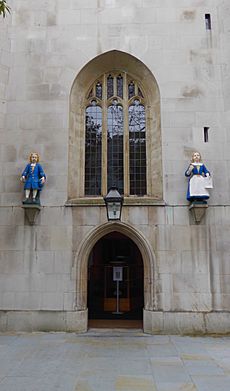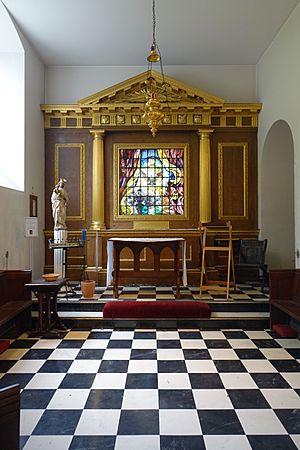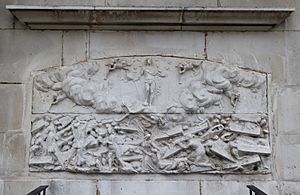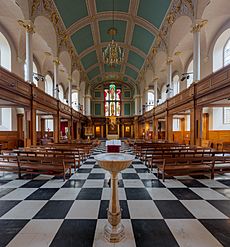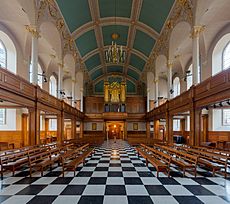St Andrew Holborn (church) facts for kids
Quick facts for kids St Andrew, Holborn |
|
|---|---|
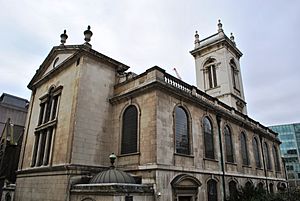 |
|
| OS grid reference | TQ 31470 81518 |
| Location | London, EC4 |
| Country | England |
| Denomination | Church of England |
| Churchmanship | Traditional Catholic |
| History | |
| Status | Active |
| Architecture | |
| Functional status | Guild Church |
| Heritage designation | Grade I listed |
| Designated | 4 January 1950 |
| Architect(s) | Sir Christopher Wren |
| Style | Baroque |
| Administration | |
| Deanery | The City |
| Archdeaconry | Archdeaconry of London |
| Diocese | Diocese of London |
The Church of St Andrew, Holborn is a historic Church of England building. It stands on the edge of the City of London, in an area called Holborn. This church has a long and interesting past.
Contents
A Look Back: History of St Andrew's Church
Early Days: Roman Times to Medieval Ages
Long ago, even before the church was built, Roman pottery was found here. This tells us people lived in this spot a very long time ago! The first mention of a church on this site was in the year 951. It was described as an "old wooden church" on a hill above the river Fleet.
Later, around the 1200s, the church was known as St Andrew Holburnestrate. In 1280, someone named Simon de Gardino left money to build a bell tower. This suggests the church was getting bigger and more important.
In 1348, a local armourer named John Thavie left a large amount of money to help keep the church in good repair forever. This gift has been carefully managed over hundreds of years. It still helps pay for the church's upkeep today! In the 1400s, the old wooden church was replaced with a stronger stone one. In 1563, lightning struck the church's steeple, causing damage.
Rebuilding and New Beginnings
The medieval St Andrew's church was lucky during the Great Fire of London in 1666. A sudden change in wind direction saved it from the flames. However, the church was already in poor condition. So, a famous architect named Sir Christopher Wren rebuilt it. He made it much larger, creating the church you see today. Wren even added a marble covering to the old medieval stone tower, which was the only part of the original church that remained.
In 1741, a kind sea captain named Thomas Coram started the Foundling Hospital nearby. This hospital was a special place for abandoned children. The church has a strong connection to this hospital.
Famous Faces and Important Events
Many notable people have connections to St Andrew's. In 1799, Marc Isambard Brunel, a famous engineer, got married here. In 1808, writer William Hazlitt also married at the church. His friends, the well-known writers Charles Lamb and Mary Lamb, were part of the wedding.
In 1817, a young boy named Benjamin Disraeli was baptized at St Andrew's. He later became the Prime Minister of the United Kingdom!
A very important event happened on the church's steps in 1828. A surgeon named William Marsden found a homeless girl who was very ill. He tried to get her help at nearby hospitals, but none would take her. She sadly died in his arms. This sad experience inspired Marsden to create the Royal Free Hospital. This hospital was specifically for poor and needy people. Today, the hospital is located in Hampstead.
In the mid-1800s, big changes happened around the church. A new road, the Holborn Viaduct, was built to connect different parts of London. This project meant that part of the churchyard had to be moved. Many bodies were carefully reburied in the church's crypt or at a cemetery in Ilford.
The church also appears in famous books! In Charles Dickens's novel Oliver Twist, a character named Bill Sykes looks up at the church's tower. Another Dickens book, Bleak House, mentions someone being buried in St Andrew's churchyard.
Modern Times: Restoration and Community
During World War II, in May 1941, the church was badly damaged by bombs. Only the outer walls and tower were left standing. Instead of tearing it down, people decided to rebuild it exactly as Sir Christopher Wren had designed it. The church was carefully restored "stone for stone and brick for brick." It reopened in 1961.
Inside the church, you can see beautiful stained glass windows and a mural (a painting on a wall) by an artist named Brian Thomas.
In 1955, some important items from the Foundling Hospital were brought back to St Andrew's. This included the remains of Thomas Coram, the hospital's founder, who was buried in a tomb here. The beautiful wooden casing of the church's pipe organ also came from the Foundling Hospital. This organ casing was designed by the famous composer George Frideric Handel! The pulpit and the baptismal font also came from the hospital.
Today, St Andrew's is a Guild Church. This means it mainly serves people who work in the area, rather than those who live there. The church holds weekly services, concerts, and lectures. In 2005, a large new icon (a religious painting) was placed in the church. In 2010, the icon of Jesus on the Cross was made motorized, so it can be raised and lowered for services.
The Church Organ
The organ at St Andrew's is a modern instrument inside a very old casing. The casing was built in the 1750s for the Foundling Hospital chapel. It was designed by the famous composer George Frideric Handel. The organ itself was built in 1989.
Organists of St Andrew's
Many talented musicians have played the organ at St Andrew's over the years. Some famous organists include:
- Daniel Purcell (1713–1717), who was related to the famous composer Henry Purcell.
- Maurice Greene (1717–1718).
- John Stanley (1726–1786), who started playing at St Andrew's when he was only 14! He also took over from Handel as a governor of the Foundling Hospital.
People Buried Here
Several notable people are buried at St Andrew, Holborn:
- Ralph Rokeby (died 1596)
- John Gerard (c. 1545–1612)
- Praise-God Barebone (c. 1598–1679)
- Swithun Wells (c. 1536–1591)
- William Stanton (1639–1705)
- Thomas Coram (c. 1668–1751)
Notable Weddings
- Marc Isambard Brunel and Sophia Kingdom (1799)
- William Hazlitt and Sarah Stoddart (1808)
See also


